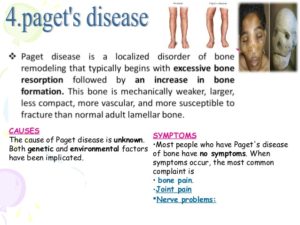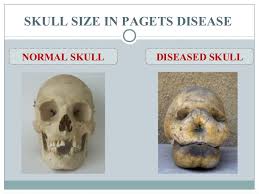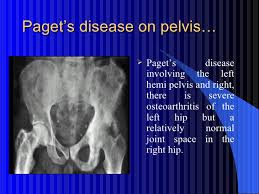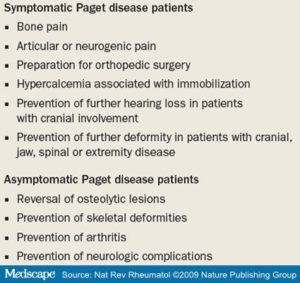

Paget’s disease is a chronic disorder that can result in enlarged and misshapen bones. The excessive breakdown and formation of bone tissue causes affected bone to weaken—resulting in bone pain, misshapen bones, fractures, and arthritis in the joints near the affected bones. Paget’s disease typically is localized, affecting just one or a few bones, as opposed to osteoporosis, for example, which affects all the bones in the body.
Scientists do not know for sure what causes Paget’s disease. In some cases, the disease runs in families, and so far two genes have been identified that predispose affected people to develop Paget’s disease. In most cases, however, scientists suspect that environmental factors play a role. For example, scientists are studying the possibility that a slow-acting virus may cause Paget’s disease.
The disease is more common in older people and those of northern European heritage. Research suggests that a close relative of someone with Paget’s disease is seven times more likely to develop the disease than someone without an affected relative.
Many patients do not know they have Paget’s disease because they have no symptoms. Sometimes the symptoms may be confused with those of arthritis or other disorders. In other cases, the diagnosis is made only after the patient has developed complications.
Symptoms could include since for many its painless:
- pain, which can occur in any bone affected by the disease or result from arthritis, a complication that develops in some patients
- headaches and hearing loss, which may occur when Paget’s disease affects the skull
- pressure on nerves, which may occur when Paget’s disease affects the skull or spine
- increased head size, bowing of a limb, or curvature of the spine, which may occur in advanced cases
- hip pain, which may occur when Paget’s disease affects the pelvis or thighbone.
- damage to cartilage of joints, which may lead to arthritis.
How you know you have it:
Paget’s disease is almost always diagnosed using x rays but may be discovered initially by either of the following tests:
- Alkaline phosphatase blood test. An elevated level of alkaline phosphatase in the blood can be suggestive of Paget’s disease.
- Bone scans. Bone scans are useful in determining the extent and activity of the condition.
If a blood test or bone scan suggests Paget’s disease, the affected bone(s) should be x rayed to confirm the diagnosis.
Early diagnosis and treatment are important to minimize complications. Siblings and children of people with Paget’s disease may wish to have an alkaline phosphatase blood test every 2 or 3 years starting around the age of 40. If the alkaline phosphatase level is higher than normal, a bone scan may be used to identify which bone or bones are affected and an x ray of these bones is used to verify the diagnosis of Paget’s disease.
The outlook for people diagnosed with Paget’s disease is generally good, particularly if treatment is given before major changes have occurred in the affected bones. Treatment can reduce symptoms but is not a cure. Osteogenic sarcoma, a form of bone cancer, is an extremely rare complication that occurs in less than 1 percent of all patients with Paget’s disease.
Stayed tune for Part II tomorrow!



